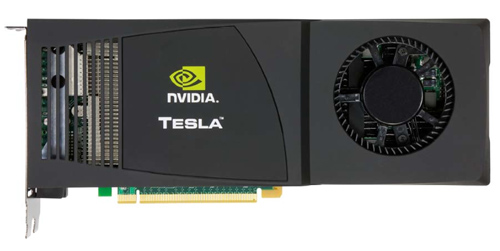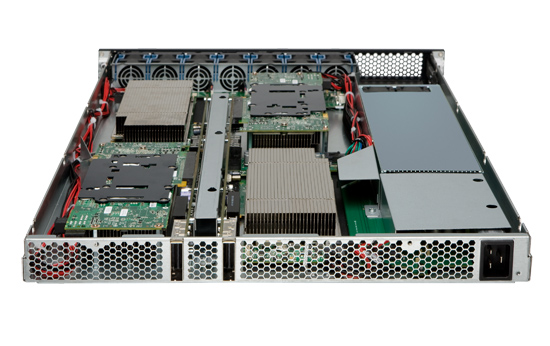NVIDIA's Fermi: Architected for Tesla, 3 Billion Transistors in 2010
by Anand Lal Shimpi on September 30, 2009 12:00 AM EST- Posted in
- GPUs
A Different Sort of Launch
Fermi will support DirectX 11 and NVIDIA believes it'll be faster than the Radeon HD 5870 in 3D games. With 3 billion transistors, it had better be. But that's the extent of what NVIDIA is willing to talk about with regards to Fermi as a gaming GPU. Sorry folks, today's launch is targeted entirely at Tesla.

A GeForce GTX 280 with 4GB of memory is the foundation for the Tesla C1060 cards
Tesla is NVIDIA's High Performance Computing (HPC) business. NVIDIA takes its consumer GPUs, equips them with a ton of memory, and sells them in personal or datacenter supercomputers called Tesla supercomputers or computing clusters. If you have an application that can run well on a GPU, the upside is tremendous.

Four of those C1060 cards in a 1U chassis make the Tesla S1070. PCIe connects the S1070 to the host server.
NVIDIA loves to cite examples of where algorithms ported to GPUs work so much better than CPUs. One such example is a seismic processing application that HESS found ran very well on NVIDIA GPUs. It migrated a cluster of 2000 servers to 32 Tesla S1070s, bringing total costs down from $8M to $400K, and total power from 1200kW down to 45kW.
| HESS Seismic Processing Example | Tesla | CPU |
| Performance | 1 | 1 |
| # of Machines | 32 Tesla S1070s | 2000 x86 servers |
| Total Cost | ~$400K | ~$8M |
| Total Power | 45kW | 1200kW |
Obviously this doesn't include the servers needed to drive the Teslas, but presumably that's not a significant cost. Either way the potential is there, it's just a matter of how many similar applications exist in the world.
According to NVIDIA, there are many more cases like this in the market. The table below shows what NVIDIA believes is the total available market in the next 18 months for these various HPC segments:
| Processor | Seismic | Supercomputing | Universities | Defence | Finance |
| GPU TAM | $300M | $200M | $150M | $250M | $230M |
These figures were calculated by looking at the algorithms used in each segment, the number of Hess-like Tesla installations that can be done, and the current budget for non-GPU based computing in those markets. If NVIDIA met its goals here, the Tesla business could be bigger than the GeForce one. There's just one problem:
As you'll soon see, many of the architectural features of Fermi are targeted specifically for Tesla markets. The same could be said about GT200, albeit to a lesser degree. Yet Tesla accounted for less than 1.3% of NVIDIA's total revenue last quarter.
Given these numbers it looks like NVIDIA is building GPUs for a world that doesn't exist. NVIDIA doesn't agree.
The Evolution of GPU Computing
When matched with the right algorithms and programming efforts, GPU computing can provide some real speedups. Much of Fermi's architecture is designed to improve performance in these HPC and other GPU compute applications.
Ever since G80, NVIDIA has been on this path to bring GPU computing to reality. I rarely get the opportunity to get a non-marketing answer out of NVIDIA, but in talking to Jonah Alben (VP of GPU Engineering) I had an unusually frank discussion.
From the outside, G80 looks to be a GPU architected for compute. Internally, NVIDIA viewed it as an opportunistic way to enable more general purpose computing on its GPUs. The transition to a unified shader architecture gave NVIDIA the chance to, relatively easily, turn G80 into more than just a GPU. NVIDIA viewed GPU computing as a future strength for the company, so G80 led a dual life. Awesome graphics chip by day, the foundation for CUDA by night.
Remember that G80 was hashed out back in 2002 - 2003. NVIDIA had some ideas of where it wanted to take GPU computing, but it wasn't until G80 hit that customers started providing feedback that ultimately shaped the way GT200 and Fermi turned out.
One key example was support for double precision floating point. The feature wasn't added until GT200 and even then, it was only added based on computing customer feedback from G80. Fermi kicks double precision performance up another notch as it now executes FP64 ops at half of its FP32 rate (more on this later).
While G80 and GT200 were still primarily graphics chips, NVIDIA views Fermi as a processor that makes compute just as serious as graphics. NVIDIA believes it's on a different course, at least for the short term, than AMD. And you'll see this in many of the architectural features of Fermi.










415 Comments
View All Comments
samspqr - Thursday, October 1, 2009 - link
ATI's availability will be sorted out soon, NVIDIA's weird design choices that are targeted at anything but graphics won'tin fact, I have just realized: NVIDIA IS DOING A MATROX!
(forget about graphics, concentrate in a proffessional niche, subsequently get run over by competitors in its former main market... eventually dissappear from the graphics market or become irrelevant? with some luck, RayTracing will be here sooner rather than later, ATI will switch to GPUcomputing at the right time -as opposed to very much too soon-, and we will have a 3 players market; until then, ATI domination all over)
andrihb - Thursday, October 1, 2009 - link
What a huge leap of the imagination :Psamspqr - Friday, October 2, 2009 - link
sorry, I was just trying to imagine how many weird things would have to happen so that we don't have a single GPU maker in the marketin any case, if you want some imaginative thinking, try here:
http://www.semiaccurate.com/2009/10/01/nvidia-fake...">http://www.semiaccurate.com/2009/10/01/nvidia-fake...
(I'm not sure yet who is the one making stuff up -charlie or nvidia-, but so far my bet would be on nvidia)
mindless1 - Saturday, October 3, 2009 - link
What they may have done is take an existing PCB design for something else, and tacked down the parts and air-wired them. It is a faster way to debug a prototype, as well as just drilling a few holes and putting makeshift screws in to test a cooling design before going to the effort of the rest of the support parts before you know if the cooling subsystem is adequate.IF that is the situation, I feel nVidia should have held off until they were further along with the prototypes, but when all is said and done if they can produce performance in line with the expectations, that would prove they had a working card.
IGoodwin - Friday, October 2, 2009 - link
First off, I don't know the truth about a fake or real Tesla being in existence; however, when an article shows a strong emotional bias, I do find it hard to accept the conclusions.Here is a link to the current Tesla product for sale online:
http://www.tigerdirect.com/applications/SearchTool...">http://www.tigerdirect.com/applications...tails.as...
This clearly shows the existing Tesla card with screws on the end plate. Also, if memory serves, having partial venting on a single slot for the new Tesla card would equal the cooling available on the ATI card. Also, six-pin connector is in roughly the same place.
As for the PCB, it is hidden on the older Tesla screen shots, so nothing can be derived.
The card may be fake, or not, but Charlie is not exactly unbiased either.
jonGhast - Saturday, October 3, 2009 - link
"but Charlie is not exactly unbiased either."What's the deal with that, I keep trying to read Semi's articles, though his 'tude towards MS and Intel is pretty juvenile, but I've got to ask; did somebody at Nvidia gang rape his mom?
mindless1 - Saturday, October 3, 2009 - link
I simply assume he is either directly or indirectly on ATI's payroll.Fudzilla wrote "The real engineering sample card is full of dangling wires." To display such a card to others they could simply epoxy down some connectors and solder the wires to them.
monomer - Friday, October 2, 2009 - link
Here's an article from Fudo saying that the card was a mock-up. Nvidia claimed it was real at the conference, and are now saying its a fake, but that they really, truly, had a real one running the demos. Really! I completely believe them.http://www.fudzilla.com/content/view/15798/1/">http://www.fudzilla.com/content/view/15798/1/
Yojimbo - Thursday, October 1, 2009 - link
What makes you think it isn't the right time? You can only really tell in hindsight, but you give in your post any reason that you think now is not the right time and later, when amd is gonna do it, is the right time. I think the right time is whenever the architecture is available and the interest is there. Nvidia has, over the past 5 years, been steadily building the architecture for it. Whether the tools are all in place yet and whether the interest is really there remains to be seen.It has nothing to do with matrox or any shift to a "professional niche." Nvidia believes that it has the ability to evolve and leverage its products from the niche sector of 3d graphics into a broader and more ubiquitous computing engine.
wumpus - Thursday, October 1, 2009 - link
Do you see any sign of commercial software support? Anybody Nvidia can point to and say "they are porting $important_app to openCL"? I haven't heard a mention. That pretty much puts Nvidia's GPU computing schemes solely in the realm of academia (where you can use grad students a cheap highly-skilled labor). If they could sell something like a FEA package for pro-engineer or solidworks, the things would fly off the shelves (at least I know companies who would buy them, but it might be more a location bias). If you have to code it yourself, that leaves either academia (which mostly just needs to look at hardware costs) and existing supercomputer users. The existing commercial users have both hardware and software (otherwise they would be "potential users"), and are unlikely to want to rewrite the software unless it is really, really, cheaper. Try to imagine all the salaries involved in running the big, big, jobs Nvidia is going after and tell me that the hardware is a good place to save money (at the cost of changing *everything*).I'd say Nvidia is not only killing the graphics (with all sorts of extra transistors that are in the way and are only for double point), but they aren't giving anyone (outside academia) any reason to use openCL. Maybe they have enough customers who want systems much bigger than $400k, but they will need enough of them to justify designing a >400mm chip (plus the academics, who are buying these because they don't have a lot of money).